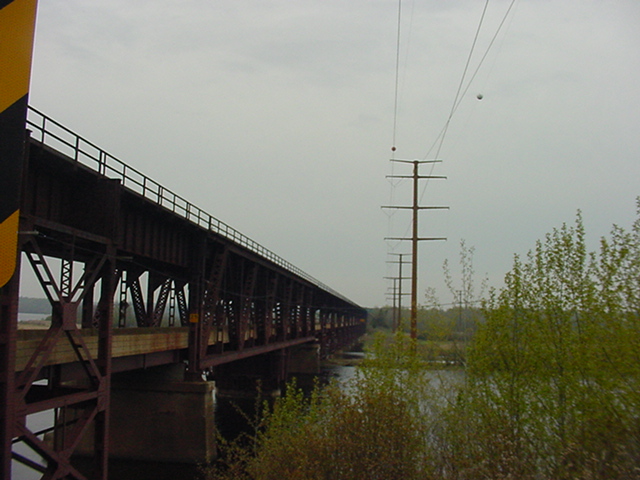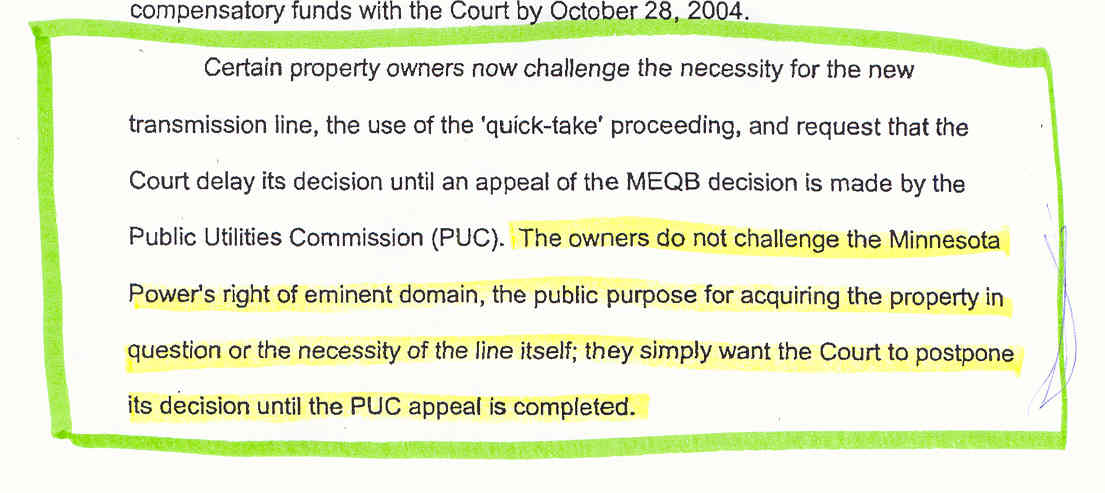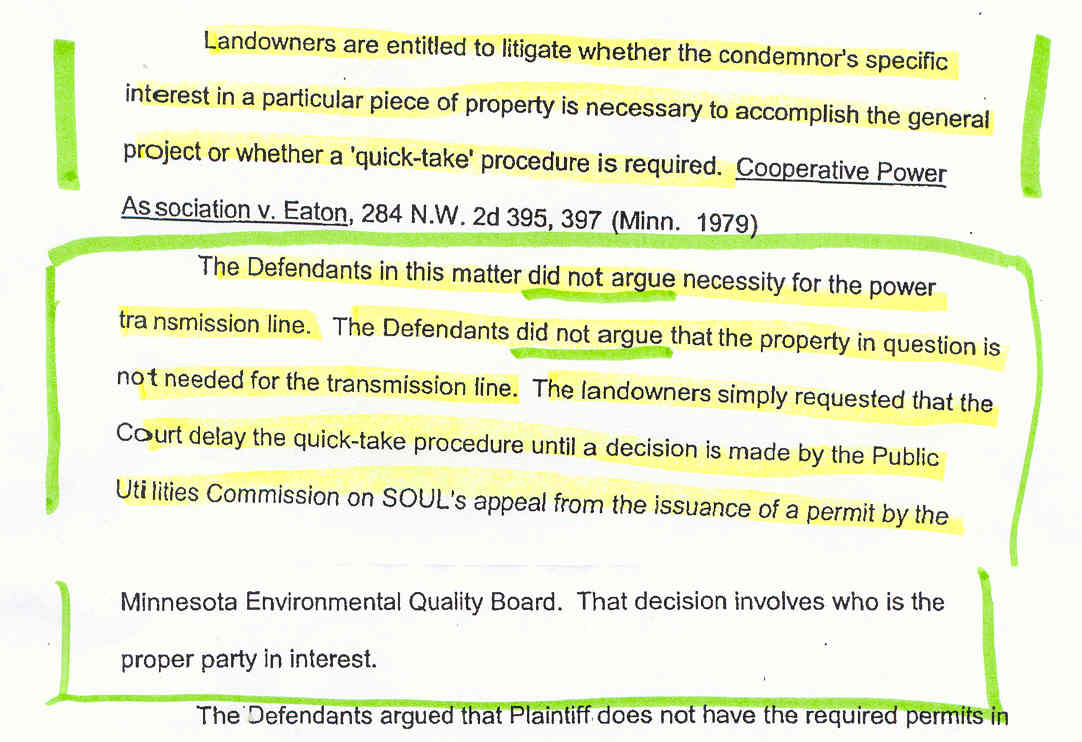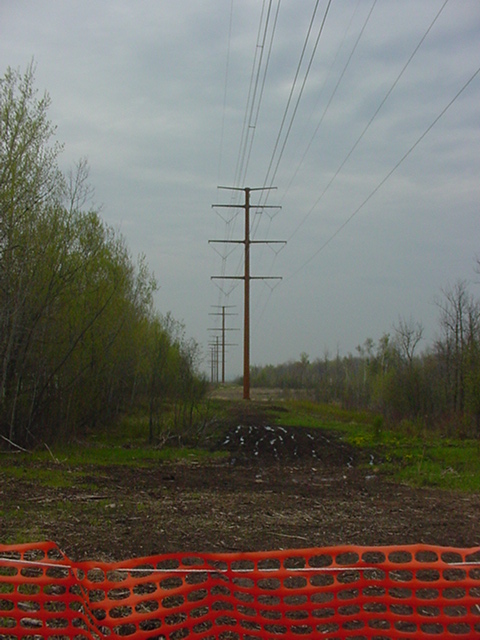Arrowhead Eminent Domain — Transmission Happens!
July 11th, 2005
Eminent Domain has been in the news thanks to the Supremes decision in Kelo, et al. v. City of New London. Compare that with the Minnesota Supreme Court’s Walser case, about public purpose. Now I’m not done wading through Kelo yet, but it seems to me that Kelo plays out no differently than eminent domain as currently operating in Minnesota, that where there’s an umbrella of a deliberate plan by a governmental unit that is “essentially” public purpose, distinct from public use, they can take land and hand it over to a private developer for a private use. The burden is on those whose land is being condemned to prove up an illegitimate purpose, or that it benefits “a particular class of identifiable individuals” (like Mesaba’s Tom Micheletti and wife??).
The only defining clue I see in the decision is the court’s emphasis on this quote from Hawaii Housing Authority v. Midkiff, 467 U.S. 229, 242 (1984):
When the legislature’s purpose is legitimate and its means are not irrational, our cases make clear that empirical debates over the wisdom of takings — no less than debates over the wisdom of other knds of socioeconomic legislation — are not to be carried out in the federal courts.
So in a case, oh, … say, like Mesaba, where it’s an illegitimate purpose and the means are irrational, sounds like the door is wide open!
Another important decision in Minnesota is the Siegel case, holding that Plaintiffs had a valid claim (which they’d have to prove up) and could proceed and enter their evidence that governmental actions that diminished the value and limited their use of their property constitutes a taking:
Although the pleadings state no claim of total worthlessness, the pleadings permit proof that the city’s and the MCDA’s actions left appellants without economically viable rental and development uses for their property and, therefore, that appellants have a right to recovery under the Takings Clause.

On the subject of eminent domain, this last week, I got a big box of exhibits from Minnesota Power. It’s the documentation requested in the Arrowhead PUC case where Minnesota Power wants to transfer ownership to ATC, and a large part of it was the easement agreements and the Condemnation Orders. It was the Condemnation Orders that were hard to take, because they revealed that the landowners did not avail themselves of the challenges open to them.
There are only a few valid challenges to a condemnation proceeding, which is governed by Minn. Stat. ch. 117, and they focus on the authority of the party taking, and a very narrow look at the “need” and public purpose for the taking. A Certificate of Need is per se “need” for the line, but there was no Certificate of Need for the Arrowhead line because the line fell just under the threshold where one is required. As a part of the EQB proceeding, Intervenors tried to raise the need issue, but after the Chisago project, the EQB stayed far away. There has been no governmental need determination in Minnesota for the Arrowhead Transmission Line. “Need” for the line is in question.
In this case, there was another opening for review, a constitutional challenge that landowners did not receive notice that the Arrowhead Exemption from the Power Plant Siting Act would eliminate their rights under the “Buy the Farm” provision — that because the landowners were not notified of the meaning and effect of the exemption, their waiver of participation was not valid. I’d raised this at the Appellate Court in the Arrowhead appeal, C4-01-1022, and had submitted the transcripts to show this WAS raised before the Board! None of the landowners knew about “Buy the Farm” or that if the project were exempted, “Buy the Farm” would not apply. But during the oral argument, the panel noted a couple of times that this argument had to be raised in the condemnation court.
As we can see in the eminent domain cases above, constructive takings happen when insufficient notice is given and when property value and land rights disappear when governments take action, a need determination must be made and there must be a public purpose for the taking, and landowners must receive proper notice of their rights and whether rights may be lost as a consequence of governmental action. None of these legitimate challenges to condemnation were made in the Arrowhead condemnation proceedings. Instead, the court notes that those defending against condemnation just wanted the condemnation decision delayed until PUC decided on the NAWO and SOUL Complaint to revoke the EQB’s exemption.
Here’s what the court thought of that — the incredulous “look over the top of its glasses” is audible — below is an example of the Arrowhead Orders, one of many, but they’re all identical, it’s broken down into Parts I and II because it’s “too large” to upload, and Part II Memo is the one with the court’s reasoning:
Part I Download filePart II Memo Download file
Here’s the short version of what the District Court said:



NAWO and SOUL filed a Complaint with the PUC to revoke the EQB’s exemption — asked one agency to overturn the decision of another! Here’s a copy of the PUC Order dismissing that Complaint and telling NAWO and SOUL to bring the request to revoke the EQB decision to the EQB.
They Arrowhead landowners were at the horse track, but ignored the ponies and bet all they had on a rescue greyhound that wasn’t even in the gate! The quick-take condemnation goes forward.
Sigh… Transmission happens!

Leave a Reply